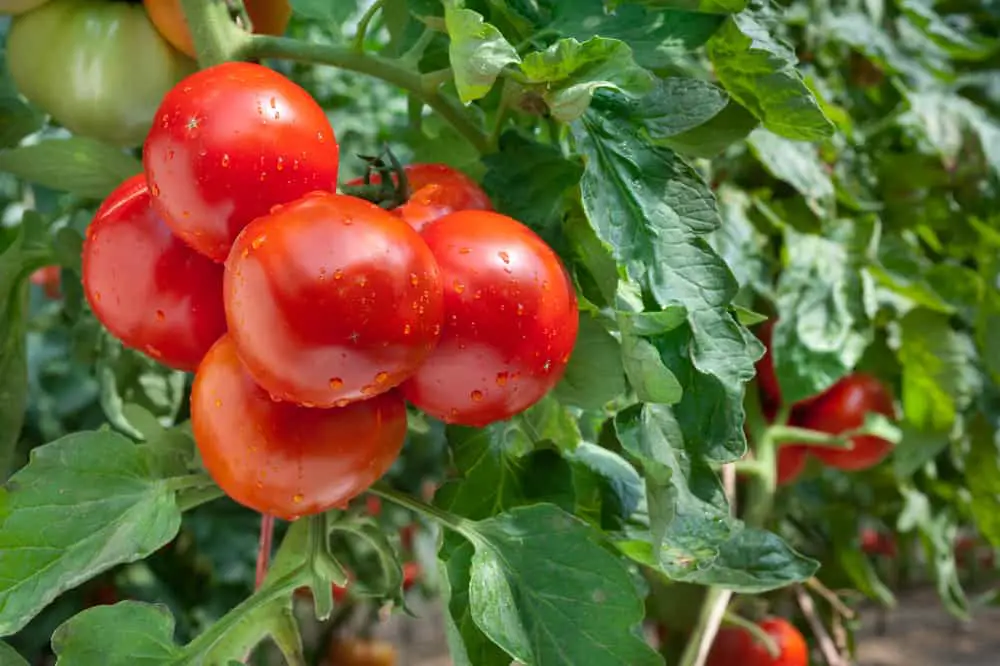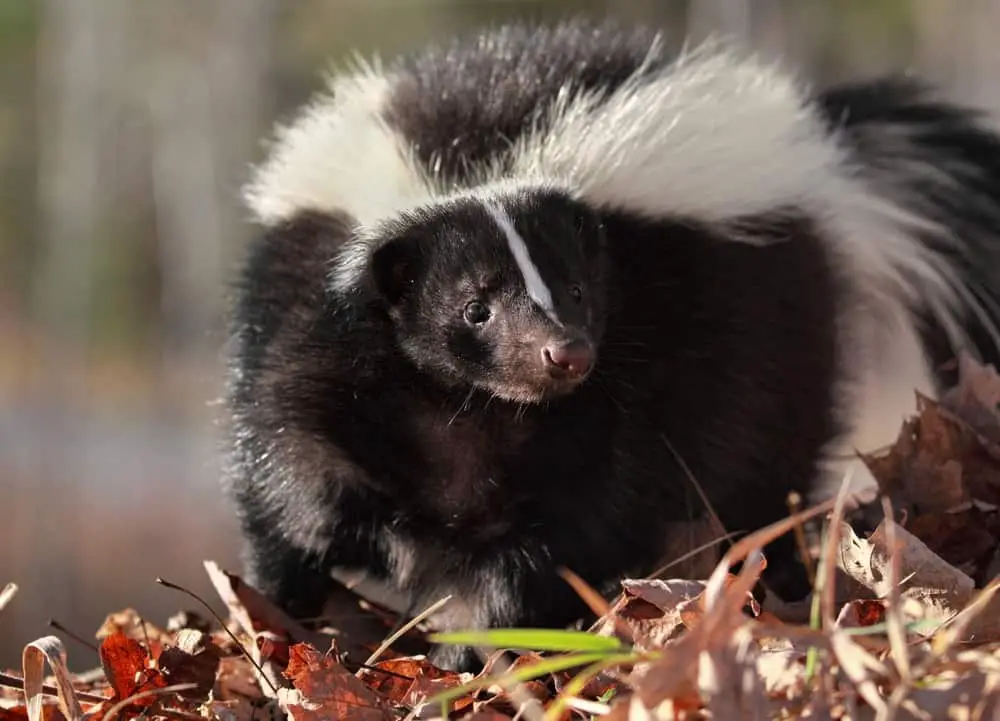Tomatoes are a mainstay of almost every home garden and a favorite for the kitchen table. But the enjoyment of the sweet aroma of ripe tomatoes isn’t only coveted by gardeners like me, sometimes it attracts pests that munch on fruit and chunks of leaves.
Skunks are opportunistic eaters and foragers of insects and fruits that dwell low to the ground. The sprawling vining of native tomatoes close to the earth has often been a dependable food source in the wild, so skunks have grown fond of the smell of ripe, sweet tomatoes. But will skunks eat tomato plants in a garden? Let’s find out!
Do Skunks Like to Eat Tomatoes?
Tomatoes are not every skunk’s favorite food, but most will eat them if they are available. The stripped skunk, which has a sweeter tooth than other types of skunks, will seek out tomatoes in gardens for a snack at night.
Skunks are unlikely to eat your entire tomato plant as they typically only nibble and take one or two bites out of the lowest-hanging fruits. Typically these bottom tomatoes will get dirty and are more susceptible to rot than higher, better ventilated tomatoes.
Because skunks only eat tomatoes at ground level, all the fruits a plant 3 feet tall or taller are safe from skunks. Skunks will not eat the green parts like tomato plant leaves or stems as it is toxic to them as it is to most mammals, humans included.
It is entirely possible to share your tomatoes with wild skunks, but you may not to too keen on the results if they spay in your garden. Skunks will eat tomatoes, but do they only munch on these ripe red fruits when they are hungry, or do they actively seek out tomato plants?
Are Skunks Attracted to Tomato Plants?
Skunks will most likely be attracted to your tomato plants for a number of reasons, only some of which have to do with eating the tomatoes. I find it important to understand what about tomato plants attract skunks and how to work with nature to make keeping skunks out of your garden even easier.
- Cover – The large bushy nature of most garden variety tomatoes makes a great hiding place for nocturnal skunks. On nights with high moon visibility, a hunting skunk may be quickly spotted by an owl or other nighttime predator.
Skunks also hunt at night and can eat anything from small insects and grubs to field mice and moles. To effectively hunt their prey, skunks rely on cover to hide their shadows. The tall bushy tomato plant leaves can guarantee cover when it comes time to strike. - Meeting Place – Healthy ripe tomatoes usually indicates a well-maintained garden. A garden full of life is likely to attract all manner of pests, like tomato hornworms and other wildlife. Skunks are attracted to meeting places such as tomato grooves and will use these areas to find food and mates.
- Abundant Food Source – Tomatoes on their own are a very healthy and nutritious snack for skunks. It has vital nutrients that a skunk needs to grow, and the high sugar content gives a sleepy skunk a jolt of energy. A bite or two of tomato goes a long way for a skunk on the prowl.
In addition to the obvious nourishment provided by the tomato fruits, the tomato plants themselves host an ecosystem that can provide alternative food sources for even a small family of skunks. Insects like tomato hornworms and small field mice, and reptiles are common animals near tomato plants and can offer a buffet for a hungry skunk and its brood.
Signs A Skunk is Chomping Your Tomatoes

Skunks do eat tomatoes and are attracted to tomato plants. They cannot resist the succulent fruit or the ease of access that a lush tomato garden can provide. But not just skunks find tomatoes delectable. Some other animals might be responsible for missing fruits.
Missing chunks of leaves and signs of pests like tomato hornworms could distract you from signs of skunks. When I need to make sure it is a skunk and not some unknown animal eating my tomatoes, I look for these bits of evidence:
| Sign | Where To Look | What It Looks Like |
| Tracks on the ground near tomato plants | look at disturbed soil and wet mud for animal tracks near the base of the plant | Skunk tracks are similar to cat tracks; however, skunks have 5 toes whereas cats only have 4 |
| One or two small animal bites | Bottom fruits around the entire tomato plant | Clear animal tooth marks on the lowest hanging tomatoes. narrow grooves but no holes like insect bites, only one or two marks |
| Damage at night | lowest tomatoes in the morning near wildlife trails | A tomato that was intact in the evening but has been bitten once or twice in the night |
| Unusual smell | near tomato plants at dawn or dusk | The telltale sign of a skunk will always be its smell; if there is a musky odor near tomato plants, it is a skunk |
Tracks
One of the most definitive ways to determine if it is a skunk eating your tomatoes is to check for tracks on the ground. Often the fertile soil around tomato plants and their seedlings is loose enough to take the impression of small mammals like skunks. Hard compacted dirt along walkways can also reveal ground tracks and can lead you to the trail skunks use to hunt. If you are able to follow the ground tracks, you can often deter a skunk from coming to your garden.
Bite Marks
The bite marks a skunk leaves on a tomato are quite distinct. Often the lowest part of the tomato will have a single narrow groove where the teeth dug into the flesh of the tomato. If you see half-eaten tomatoes, the bite marks resemble holes, or if tomatoes high up on the plant are attacked, it is likely not a skunk and more likely a raccoon, squirrel, or chipmunk. Also, if seedlings or tomato plant leaves are damaged, it is likely not a skunk.
Nighttime Damage
Skunks are nocturnal and voracious eaters. If your tomatoes are fine in the morning and eaten in the evening, most likely, a skunk had nothing to do with it. However, if the evening inspection of your garden beds full of tomatoes shows no pests but in the morning there is damage to tomato plants, then you could have a skunk problem. They are messy eaters, although not the messiest eaters and will leave evidence of their meals.
Skunk Smell
It’s hard to ignore the smell a skunk leaves behind. Even when it doesn’t spray, its musk can hang heavy in a garden. The scent of a skunk, along with distinctive tracks on the ground, is a sure way to identify if skunks are feasting on your fruits. You can use the strength of the skunk smell to tell where the skunk fled and possibly use that information to protect your garden from skunks and other animals.
How To Stop Skunks from Eating Tomato Plants
When I know for sure that a skunk and not a raccoon, mouse, or other nocturnal animal has been eating my tomato plants, I take steps to protect my beloved tomatoes. Fences are always a reliable option. A perimeter fence around the yard is the first line of defense against pests, and a smaller fence around the garden beds can help too.
Sometimes more extreme fences like an electric rabbit fence may be needed if your garden lies along a major skunk trail. If fences aren’t working, then there are other solutions you can try as well.
Strong-smelling deterrents such as vinegar, human hair, or predator urine can repel skunks from your gardens and keep your tomatoes safe. Other options include making a mesh-cage house around each tomato plant or a large cage to house the entire garden. Use strong wire mesh to keep all larger pests out.
While other pests may attack tomato plant leaves and stems like tomato hornworms, skunks are only interested in ripe fruits. Skunks are unlikely to remove chunks of leaves from tomato plants or damage seedlings. Birds and other pests might be causing those problems to your tomato patch.
Skunks look for food low to the ground and will not eat fruits high up on the tomato plants. Raised garden beds will lift even your lowest-hanging tomatoes higher than a skunk is likely to look. Birds and raccoons will still be a problem, and rat droppings could indicate field mouse problems.
Where Do Skunks Hide?
Skunks can be lurking around your tomato plants, and you might have no idea. they live in holes in the ground and come out at night to hunt and forage for food. Ripe tomatoes attract skunks with their sweet aroma and can lure them into your garden beds. Like field mice, skunks look for holes in fences and other ground entrances to your garden.
Skunks can climb but can be scared away from your lawn through a few methods. Skunks will hide from anything they perceive as a threat. To cause skunks to hide and leave your tomatoes alone, you can use motion-activated sprinklers. Motion-activated lights can also be wired to scare skunks out of your garden and back to its hole.
Keeping tomatoes safe from skunks takes some effort, especially if your house is near a skunk trail. Other predators like tomato hornworms, field mice, and raccoons are still a threat, but these methods are sure to protect tomato plants from hungry skunks.


